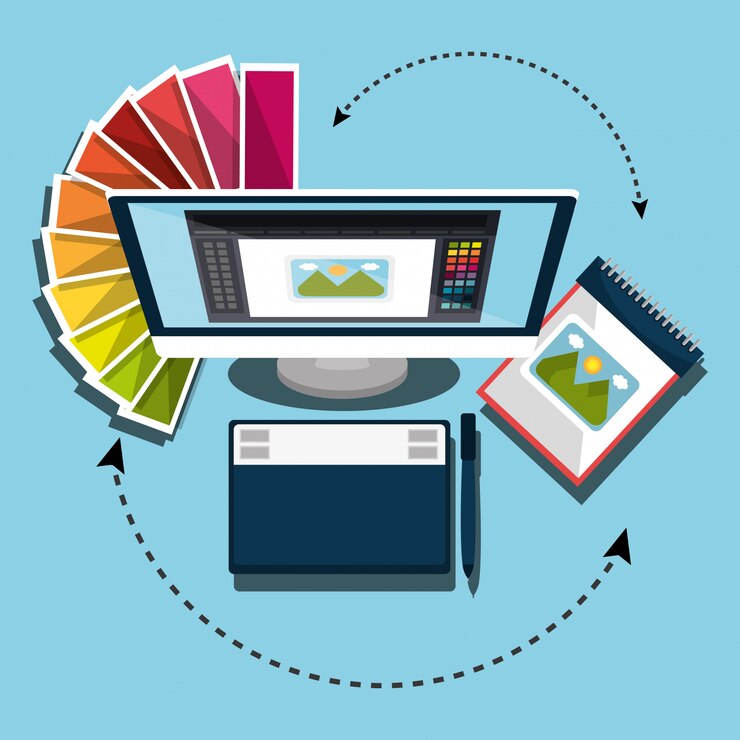Over time graphic design has revolutionized over these decades, especially with the help of technology that helps designers display their works. Before the advent of computers, designers used many basic techniques, such as drawing illustrations manually and manually cutting pieces to paste them on layouts. However, with the advancement in computing technologies, many graphically inclined design solutions cropped up, which signaled a new age in creativity. As for today, every tool is shiny, practical, and connected to the cloud, but it’s worth remembering the old graphic design software that somehow has shaped modern design.
So, let’s go back in time and examine the history, meaning, and impact of the most influential early Graphic Design Software.
1. The Beginnings of Digital Design

Graphic design was more or less conventional before the beginning of the 1980s compared to the contemporary world. Nevertheless, the application of personal computers provided new opportunities. The arrival of primitive graphic design software was the first major milestone that could be noted.
MacPaint (1984)
MacPaint, which came with the first Macintosh, was among the first image editors that helped make pixel art and drawings on a computer possible for the commoner. While being very primitive by today’s standards, it enabled users to create only black-and-white bitmap images using tools like brush, eraser, and paint bucket. The DOS-based designs of those early years were straightforward to use thanks to their GUI and compatibility with the recently introduced mouse accessories.
Adobe Illustrator (1987)
Initially released by Adobe, Illustrator was a vector drawing application that provided sharp and enlarging graphics. Its Bézier curve technology was a breakthrough in logo design illustrations and icons. Also, vector graphics were not blurred, unlike bitmap graphics, which appear to be made up of tiny dots that become blurred when enlarged. Adobe Illustrator, the first debut of Adobe in the design software market,
2. Traditional Graphic Design Software of the 1990s
The 1990s was quite a transformational period for this field of graphic design. Due to advances in hardware and the increasing affordability of personal computers, the designers got their hands on what was previously exclusive to large-scale studios.
CorelDRAW (1989)
CorelDRAW is an efficient tool for working in the field of desktop publishing and vector illustration. It provided a more friendly approach to design than its contests, better for both professional and non-professional individuals. Extremely powerful and, importantly, relatively affordable, CorelDRAW earned its place among small business and freelance designers. Its novelty further embraced color management and import/export of various file formats.
QuarkXPress (1987)
QuarkXPress was originally page layout software, the industry standard for publishing in the early to mid-1990s. Designers employed it to produce almost anything, from magazines to newspapers to brochures and books. Its advanced typography controls, layout accuracy, and print quality offered it a crucial standing for working professionals in the print design domain.
3. The Impact of Photoshop on Graphic Design
Of course, it is only possible to talk about old graphic design software by thinking about Adobe Photoshop, perhaps one of the most revolutionary software ever created. The program began in 1990 as a simple bitmap editor for photo touch-ups but soon became a universal graphic design software.
Key Features of Early Photoshop Versions
- Layer Functionality: Layers were new in Photoshop 3.0 (1994) and provided the designers with new levels of composition control.
- Clone Stamp Tool: This tool is used to sharpen pictures, and photographers and graphic designers relish it.
- Custom Brushes: The first versions allowed you to design your own brushes and use them in your creations.
This versatility of Photoshop led it to become the software of choice for tasks as diverse as photo editing, digital art creation, graphic design, and web design.
4. The Rise of Multimedia and Animation Tools

When multimedia became popular with technological advancement in the late 1990s and early part of this century, new software was developed to meet the new needs.
Macromedia FreeHand (1988)
Macromedia FreeHand was another Graphic Design Software like Illustrator, but people liked it and used it because of its simplicity and the features necessary for multimedia development. Designers often employed it to produce movement graphics, symbols, and complex illustrations. After Adobe acquired Macromedia in 2005, FreeHand was wholly removed from the market, but its traces are still visible in existing tools.
Macromedia Flash (1996)
Initially created for web animation, Flash became a symbol of Internet Protocol in the early 2000s. It enabled designers to design online applications, sites, games, and even animations. However, mainly because of the emergence of HTML5, Flash has had a pivotal role in web design development.
5. The Transition from Old to Modern Tools
During the early 2000s, several older graphic design software programs began to lose their presence as new, more comprehensive solutions appeared. This change was brought about by enhanced hardware technology, the increased usage of digital media, and an enhanced user expectation.
Limitations of Old Graphic Design Software
While revolutionary for their time, older software often faced limitations:
- Hardware Dependency: Programs such as MacPaint were constrained with available processing power and memory of early computers.
- Lack of Integration: Designers often use one tool to complete one part of a design and another for the next part.
- Steep Learning Curves: However, the programs were not as intuitive for a first-time user or a new user as one might have expected.
These challenges drew the way for modern periods with delicate software such as Adobe Creative Cloud Affinity Designer and Canva.
6. Nostalgia and Legacy

Today, most old graphic design software is fondly remembered by those who have worked with it. It embodies an era when designers had a more limited choice of options, leaving them with no choice but to explore different courses of action. Old software has also benefited from being used by artists who wish to create a vintage look in their animations.
Modern Appreciation
- Retro Art Styles: Pixel art, deriving from applications like MacPaint, is back in gaming and digital art.
- Preservation Projects: People interested in the subject and museums have done their best to save these early tools to show younger generations how it was.
Critical Lessons from the Past
These changes in graphic design software prove that designers need to be flexible and continuously introduce adjusted creations based on clients’ requirements. Some of the features that can be considered basic nowadays, such as cloud storage and real-time collaboration, were unthinkable when initial design tools were developed.
Conclusion
Old graphic design software reflects human creativity and technological advancement. From graphics created with MacPaint and the simple lines of CorelDRAW to applying transformations with the help of Photoshop, all these programs created the basis of today’s tools.
When noting the excellence of modern graphic design software, it will be only fair to pay deep respect to those who started it. Indeed, all of the functions that we employ today in our applications and gadgets are attributable to these pioneers of the old tools. This way, we get the chance to understand the past of a profession and embrace the future that belongs to graphic design.
























